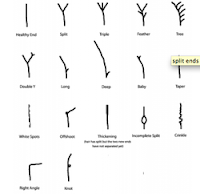To Trim or Not to Trim?
11:57 AMIt's not uncommon for women to shy away from scissors, in fact, our society is slowly becoming obsessed with the length of one's hair and forgetting all about the most important concept - the health of the hair. Many forget that as our hair grows, it ages, and the different conditions we put our hair through can cause damage over time.
How Do I Know If I Need to Trim My Ends?
No matter how often you deep condition, finger detangle, or protective style, it is nearly impossible to prevent all of the haunting characteristics that come with natural hair territory. Yes, you may prevent a plethora of them, but single strand knots, split ends, and thinning ends are practically inevitable over time.
1. Single Strand Knots
These are basically tiny little knots along the hair shaft. These knots weaken the shaft at these points of contact. They can be reduced by maintaining moisture in your strands with oils and butters, also by stretching the hair by braiding or twisting the hair while detangled. However, once you get the knots, they are practically impossible to get rid of aside from a dusting or trim. Untreated single strand knots can lead to...
2. Split Ends
Split ends are results of breakage, stress on the shaft, and dry hair. If you have single strand knots that you allow to reside in your hair, your hair can break off at this point leaving a split end. Split ends not only look bad in large quantities, but can grow into bigger problems if they begin to split up the hair shaft. This could be the difference in a trim of 1/4" and a 2-4" hair cut. When you start spotting split ends, it's typically time for a trim.
3. Lifeless Curls
Are your curls a little lifeless and weighed down at the ends? If your hair lacking it's normal bounce and elasticity? Sometimes a trim can help bring the life back into your curls! Ridding your hair of damaged and dead ends can restore elasticity and give a healthy glow to your curls.
4. Frizzy Hair
Often times frizzy hair can be a sign that your hair needs a trim, sometimes a deep conditioner and maybe a protein treatment can help, but if the frizz continues it may mean you need a trim. This is especially true if the frizz is concentrated in your ends. A good trim or dusting of your ends should help tremendously.
It's best to trim these away as you encounter them, but the easiest hair maintenance rule to remember is to get a trim every 6-8 weeks. * You will maintain healthy hair growth and retain more because you are protecting your shaft with the preventative measures of trimming. Regular trims can help naturals maintain an overall healthier looking curl pattern, and to have a healthier glow from root to tip. And remember, it's just hair, it will grow back. If you stay on a trimming regimen, you should retain your length more effectively and ultimately have to cut less.
*Remember that everyone's hair is different. One may need to trim after 6-8 weeks while others may not need a trim for 3-4 months. These are just helpful hints.
Much love,
xoxo Curly Kay





0 comments